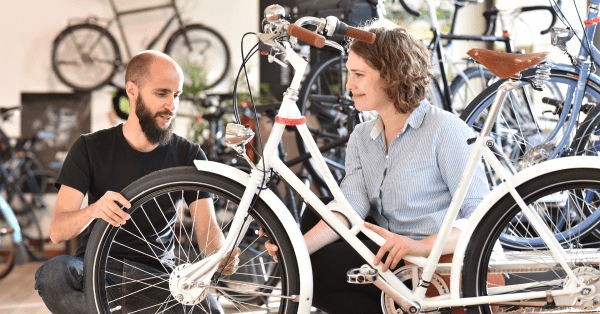Hints For Purchasing A Bike
When you’re thinking of purchasing a bike, your local bike shop will be your best resource.
1. First, give some thought to what kind of riding you want to do, your level of experience, and your overall approach to cycling. Why do you want to ride? For fitness? Just for fun? Casually, or seriously? Where do you want to ride? Street, bike trail, or off-road? How frequently do you plan to ride? The more you know what you want, the easier it will be to work with your local bike store to select a bicycle that will best suit your needs.
2. Find a good professional servicing bicycle dealer in your area. Many of the best belong to the National Bicycle Dealers Association and display the NBDA membership sticker in their windows. Tell the professionals there that you are thinking of purchasing a bike, what your desires are, and let them advise you on appropriate bicycles for your needs. Pick a store where you are comfortable, where you are treated with respect, and where they listen to you. Professional bicycle retailers can fit you properly to a bike, assemble it professionally, and give you the kind of advice and continuing service you need to ride safely and comfortably. Beware of retailers who do not have on-site service departments, or do not offer these kinds of services. They may not meet your needs. Visit NBDA’s online dealer finder to find a professional bicycle retailer near you.
3. At most bike stores, you’ll probably be seeing these kinds of bicycles:
- Mountain bikes. These are rugged bikes for off-road use, but many people ride them on pavement as well. Mountain bikes feature fat knobby tires for comfort and traction, flat bars for great control, and low gears for easier hill climbing. Some mountain bikes have suspension for increased shock absorption. Do you need suspension? It depends on how and where you plan to ride.
- Road bikes. These are meant for pavement riding and are built for speed. They have narrower tires and drop bars for a more aerodynamic position.
- Hybrid bikes. These are a cross between mountain bikes and road bikes — for the rider who wants to do a little of everything. Hybrids generally have treaded tires that are narrower than mountain bike tires, flat bars, and higher gearing than mountain bikes. They’re not quite as fast as road bikes on pavement, and not quite as rugged as mountain bikes on the road. They’re good for commuting and offer a compromise which appeals to a lot of people.
- Cruisers. One-speed or multi-speed, cruisers are for the casual rider who wants to, well, cruise.
- Juvenile bikes. These come in many varieties, from one-speed cruisers to performance BMX bikes, to multi-speed mountain and road bikes.
- Comfort bikes. These are specialized mountain bikes or hybrids with more upright riding positions, softer saddles, and lower gearing. They’re built for, as the name implies, comfort, but are also designed to perform well.
- Recumbents/tandems/electric-assist bikes. There are numerous “niche” bicycles available today. Recumbents allow people to ride in a “recliner-chair” position with feet forward. Tandems allow two riders on a bike. Also, a number of companies are offering bicycles with electric-assist motors.
4. The size of the bicycle is critical for comfortable riding. Work with your retailer to determine the proper size for you. Some bicycle models have eight or more sizes. The length of your inseam determines the correct frame size, in terms of stand-over height. The reach to the bars is also critical for comfort. Ask your bicycle dealer to recommend a proper fit for you based on the kind of riding you’ll be doing. What’s comfortable for one style of rider may not be for another. Like a shirt, the fit is very important for comfort and security.
5. When purchasing a bike, make sure to buy what you like. Feel good about what you’re buying, how it looks, how it rides. Ask to take a test ride to compare bikes. If you haven’t ridden a dealer-quality bicycle before, be prepared to be surprised at the exceptional value and quality available today. We also advise that if you’re in doubt, buy the slightly better bike. There’s a lot of value in bicycles these days, and a little more money spent can equal significantly improved performance and resale value.
6. Ask the bike store for advice on things you may not understand, such as quick-release operation, shifting, braking, maintenance, etc. If you want to find other local cyclists in your area to ride with, ask the shop for reference to clubs or organized rides. Be sure to receive an owner’s manual with the bicycle, and read it. The owner’s manuals contain valuable information to help make your experience safer and more fun.
7. Ask for advice on other equipment you may need or want. Buy a helmet first, and wear it. There are many other products that can enhance the riding experience (see related article). There are numerous books and magazines available to help you educate yourself about the nuances of cycling.
8. Have fun, and ask your bike retailer if you have problems or questions. If you’re not receiving the kind of service you want, look for another retailer. There are 5,300 specialty bike stores in the United States, and the vast majority serve their customers with dedication and flair. When you find one, that store can be your greatest ally for enjoying the cycling experience.

Now is the time to become a member as we join together to make one another stronger. Whether you’re a retailer or an industry partner, your membership in the NBDA is one of the best investments you’ll make this year.
Learn more about the benefits of being a member and join now.

